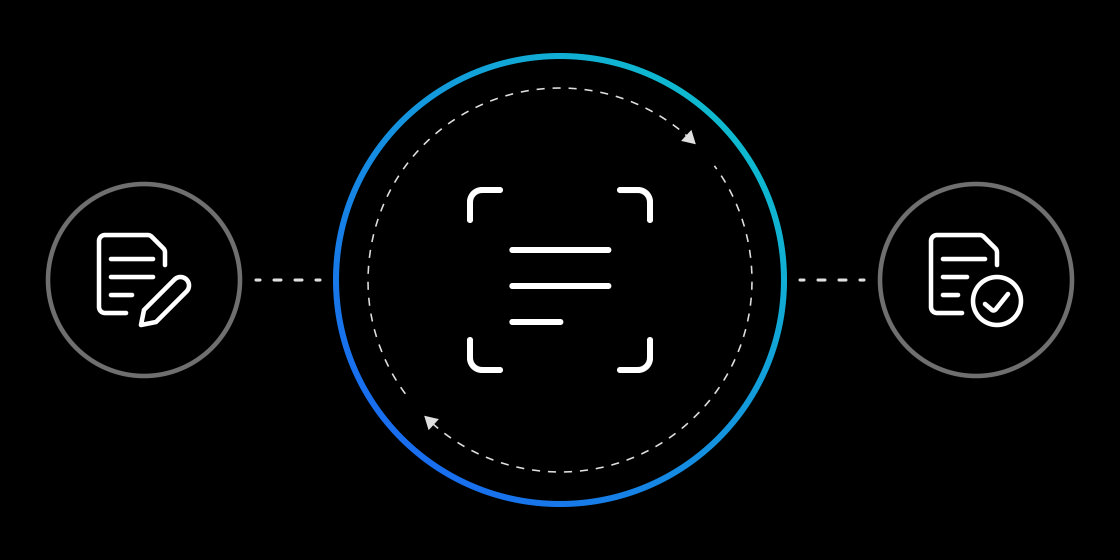What is OCR and why is it so hard to get right?
Mar 10, 2022 by Automation Hero

Artificial intelligence is one of the most complex and in-demand tech fields, but it has incredibly humble beginnings. Optical character recognition (OCR) was one of the earliest forms of AI. Developers created the principles of machine learning by teaching computers to look at images and identify individual letters and numbers so they could be converted into character codes.
So what is OCR? As the name implies, it’s a technology that looks at images of text and recognizes collections of pixels as letters or words. OCR makes it possible to turn words from scanned PDFs or images into text that can be edited or copied without manually retyping. If you’ve ever opened a scanned PDF document and been able to conveniently copy and paste the text into a word document, you have OCR to thank.
What is OCR useful for?
How often do you deposit checks by taking a picture of them in your bank’s app? Or scan paper documents into a program that lets you edit or search the text? Both of these conveniences are largely powered by OCR technology, and if you think they’ve made your life easier, it’s a drop in the bucket compared to the benefits it’s provided to businesses. As you can imagine, the biggest impact has been on data entry, but these functions have a drastic effect on every area of an organization.
Some of the biggest benefits include:
Higher productivity
Eliminating manual data entry drastically cuts processing time for each document and streamlines database upkeep.
Savings
The improved productivity translates to direct cost savings, allowing more work to be done by fewer workers. Even better, organizations can scale up their revenue-generating activities without added costs of expanding the workforce, improving profitability.
Greater accurate data entry
OCR makes fewer errors in translating images to text when compared to humans, who can be prone to misreading documents or making typos — especially when they get tired. A study of manual data entry processes found that typing is only 96% accurate for single-keyed data, which can result in a significant number of errors in large-scale operations.
What is OCR struggling with?
OCR has been a major boon for business productivity and convenience across every single industry and type of organization. Unfortunately, it’s hard for many programs to get right, especially when it’s used as a standalone solution. Here are some of the biggest disadvantages with OCR as it currently exists.
Less than perfect accuracy
Though OCR is significantly better at data entry than people, it’s still possible for it to miss letters, key words, and other important information. Of course, workers can often catch these mistakes while reviewing, but needing this type of oversight hampers productivity and prevents full automation.
Bad or low-quality documents
OCR data entry mistakes become even more likely when a document is poorly scanned, blurry, or low resolution. Low-quality documents are becoming increasingly common as people use cell phone cameras instead of scanners to digitize paper. Humans may be able to use context clues to read and understand muddy text, but OCR tools don’t have that kind of reasoning capability. If a letter or word is too blurry for the software to recognize as text, it will skip it over without realizing it missed anything.
Complex documents
Pages with a lot of design features — including elements as simple as colored backgrounds — can make it difficult for OCRs to recognize characters. This may limit the types of documents and formats that organizations can automatically process — such as invoices with graphical elements or other highly stylized documents.
Handwriting
Even though digital documents are increasingly becoming the norm, the number of handwritten documents used still warrants an automation solution. This is especially the case for organizations with physical offices and mail-based workflows that want to remain competitive with digital startups. There are also whole archives of legacy handwritten documents that organizations may want to digitize. AI has evolved to understand the direction of pen strokes to make deciphering handwriting easier, but accurately translating cursive scribbles into usable data remains a challenge.
OCR’s future
Even though OCR is ubiquitous, the future of digital transformation rests on making the technology more efficient. That means more investment in handwriting analysis, which will also improve accuracy of reading typed characters in documents of all types. For now, OCR is an excellent tool to integrate with other types of automation technologies. Already, it’s helped organizations save thousands of hours on document processing time each year, and soon it will play a vital role in fully automating all kinds of paperwork.
Close Window
Automation Hero will track how you use the emails (e.g., at what time you open which part of the emails) sent by Automation Hero. If you have provided a separate declaration of consent that cookies for tracking your usage of the website and/or apps may be placed on your device, Automation Hero will also connect the information about your use of Automation Hero’s websites and apps (e.g., which information you open) collected by the tracking cookie to such information in so far as possible. Automation Hero will analyze such information, to identify your interests and preferences and to communicate with you in a more personalized and effective way, e.g. by providing information that you are likely interested in, like information on new technologies or products of the Automation Hero group that are likely relevant to you.

The LIBOR transition: Intelligent automation to the rescue
Ready to try an innovative automation solution today? Call us today to schedule a demo.
